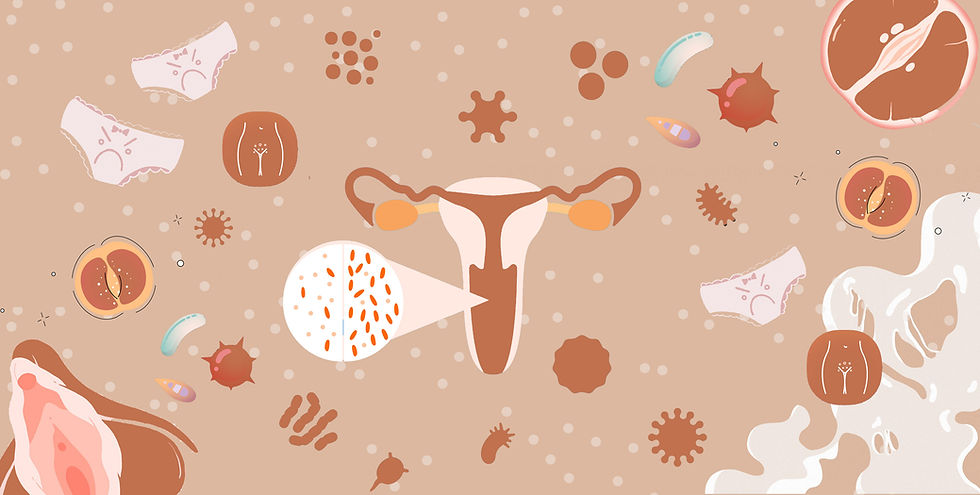Understanding Vaginal Infections: Trichomoniasis
- hello479464
- Oct 23, 2023
- 3 min read
Updated: Oct 25, 2023

Accounting for around 15-20% of all cases of vaginitis, trichomoniasis or “trich” is the third most common cause of vaginal infections after bacterial vaginosis (BV) and vulvovaginal candidiasis (also known as yeast infection or thrush). Approximately, 20 out of every 1000 individuals are affected by trichomoniasis each year in South East Asia, although the exact number for Singapore is unknown.
What is trichomoniasis?
Trichomoniasis is an infection of the vagina and the surrounding area. What separates trichomoniasis from the other two vaginal infections, BV and candidiasis, is that trichomoniasis is a sexually transmitted infection (STI). It is the most common cause of non-viral STI in the world.
Trichomoniasis is caused by a parasite known as Trichomonas Vaginalis, unlike other common STIs that are caused by bacteria and viruses.

How does Trichomoniasis occur?
Once acquired, the parasite causing trichomoniasis can survive in a moist environment for a few hours and be passed from one person to another through any contact, direct or indirect. However, venereal transmission (that is, transmission through sexual contact) accounts for almost all cases of trichomoniasis.
Women and men can both acquire trichomoniasis, but women are usually affected more frequently and experience symptoms more often than men. Both, symptomatic and asymptomatic people can spread the infection and this necessitates treatment for anyone carrying the infection.
What are the symptoms of trichomoniasis?
Women may notice or experience:
Increased vaginal discharge with unusual consistency
Discomfort, pain, or burning sensation while urinating
Foul-smelling, yellow or green foamy vaginal discharge
Itching, redness, burning, or soreness in and around the genitals
Pain after sexual intercourse
Vaginal spotting after sexual intercourse
Men usually do not have any symptoms, but may experience the following:
Itching sensation from inside the penis
Burning sensation while urinating
Burning sensation after ejaculation
Abnormal penile discharge
Without prompt treatment, the infection can last for months to years.

How to diagnose trichomoniasis?
Trichomoniasis can be diagnosed by visualizing a sample of the vaginal secretion for women, or urine for men, under a microscope. The sample can be collected at a clinic or self-collected at home and sent the the lab for assessment. If the parasite can be seen under the microscope, no further tests are needed. If this test isn't conclusive, tests called rapid antigen tests and nucleic acid amplification may be used.

How to treat trichomoniasis?
Whether any symptoms are present or not, a person with a confirmed infection should be treated to reduce the chances of further transmission and to prevent any complications.
Since trichomoniasis is caused by a parasite, antibiotics cannot be used to treat it. The treatments required for trich are anti-parasitic, such as:
Metronidazole (Flagyl) tablet, taken as a single dose or 7-day regimen, or
Tinidazole (Tindamax) tablet, taken as a single dose.
These medications are prescribed by a doctor and are also safe and effective for treatment in pregnant women.
It is recommended to refrain from consuming alcohol during treatment and 24-72 hours after treatment. This is because alcohol interacts with these medicines to produce an adverse reaction called a disulfiram-like reaction. This causes severe nausea, vomiting, headache, abdominal pain, and other hangover-like symptoms.

What happens if trichomoniasis is left untreated?
If left untreated, the infection will persist and significantly increase the risk of transmission to sexual partners.
Trichomoniasis can sometimes cause complications such as:
Contracting other STIs, especially HIV, more easily than those who complete treatment
Poor outcomes for the baby in pregnant women, such as pre-term birth or lower body weight at birth
Rarely, pelvic inflammatory disease (PID), which can cause infertility.

How to prevent trichomoniasis?
Trichomoniasis can be completely cured and there are a few ways in which future recurrence can be prevented:
Encourage your partner(s) to get treated, even if they do not have any symptoms. Prompt treatment of all partners has shown to reduce transmission and prevent a recurrence
If a partner is hesitant to see a doctor, get medicines on his/her behalf
Refrain from engaging in sexual activities until treatment is complete for both you and your partner(s)
Use barrier protection, like a condom
After completion of treatment, a follow up is not necessary.
We hope you found this article useful. Feel free to reach out of us if you have any questions. If you notice any symptoms, would like to consult a doctor, or get a test for trichomoniasis, check out our services here.
___________
References
Kasper, D. L., et al. Harrison's principles of internal medicine (20th edition.). New York: McGraw Hill Education., 2018. (pg. 1619-1620)
Ralston, Stuart H. Davidson’s Principles and Practice of Medicine. 23rd ed. Elsevier Health Sciences, 2018. (pg. 335-336)




Comments